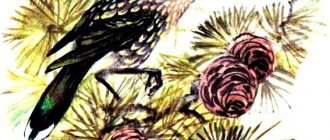When we raise our eyes to the sky, we see a lot of interesting things: during the day - the bright sun, airy clouds, a rainbow after rain or thunderclouds, and at night we watch the moon and admire the twinkling of many stars. The huge world above our heads is called the Universe or space. Space is so big that scientists still don't know much about it. For many years, people have been exploring outer space with the help of telescopes and spacecraft that explore the far corners of the Universe. Thanks to these inventions, we learned a lot of interesting things: what is the size of the sun, is it possible to live in space, and how long does it take to fly to other stars. However, the Universe is so huge and diverse that there are still many amazing discoveries ahead.
Development and education of children from 2 to 11 years old in a playful way
Start practicing right now
Start practicing
What is the Sun?
The sun that we see every day is a large and bright star. And what is it? A star is a huge hot ball of gas. There are a lot of different stars in space, but they are so far from us that they seem to us like small luminous points. The Sun is the closest star to us, so we see it very well. The bright and hot Sun gives light and warmth to all living things - from trees and flowers to animals and people.
Our home is planet Earth
If the Sun is a ball of gas, then maybe we also live on a star? Of course not. Under our feet there is a hard surface on which we can walk, run, rollerblade and ride a car. This cannot be done on the Sun, because it consists of gas. What then should we call the place where we live? Welcome to planet Earth! A planet is a space object that looks like a huge ball. There are several other planets near the Earth, and they are all very different: large and small, cold and hot, fast and slow. Let's get to know them!
Sun
The Sun is the star around which all the planets and satellites in the solar system revolve. It consists of hydrogen and helium. The age of the Sun is 4.5 billion years, it is only in the middle of its life cycle, gradually increasing in size. Now the diameter of the Sun is 1,391,400 km. In just the same number of years, this star will expand and reach the orbit of the Earth.
The sun is the source of heat and light for our planet. Its activity increases or becomes weaker every 11 years.
Due to the extremely high temperatures on its surface, a detailed study of the Sun is extremely difficult, but attempts to launch a special device as close to the star as possible continue.
Planets of the Solar System
In addition to the Earth, there are many other planets in space, but there are very few of them near us - only eight. These planets, together with the Earth, revolve around the star closest to us - the Sun. It attracts planets to itself as if they were its relatives. Scientists called such a cosmic family the Solar System. There are eight planets in the solar system. If you arrange them from closest to the Sun to the farthest, then the first will be Mercury, the second will be Venus, the third will be Earth, the fourth will be Mars, the fifth will be Jupiter, the sixth will be Saturn, the seventh will be Uranus, and the eighth planet will be Neptune. Planets are not just are close to the Sun, and all the time they revolve around it along their path, as if they were dancing in a circle. This path is called an orbit. Each planet has its own orbit, for example, the Earth makes a full revolution around the Sun in 365 days or, in another way, in one year. Did you know that each planet not only revolves around the Sun, but also rotates around its axis like a top? We call one revolution around its axis a day. On Earth, a day lasts 24 hours, but on other planets, a day passes either faster or much longer.
Terrestrial group of planets
Mercury
This planet is one of the smallest in the solar system, its diameter is 4,879 km. In addition, it is closest to the Sun. This proximity predetermined a significant temperature difference. The average temperature on Mercury during the day is +350 degrees Celsius, and at night - -170 degrees.
If we take the Earth year as a guide, Mercury makes a full revolution around the Sun in 88 days, and one day there lasts 59 Earth days. It was noticed that this planet can periodically change the speed of its rotation around the Sun, its distance from it and its position.
There is no atmosphere on Mercury; therefore, it is often attacked by asteroids and leaves behind a lot of craters on its surface. Sodium, helium, argon, hydrogen, and oxygen were discovered on this planet.
A detailed study of Mercury is very difficult due to its close proximity to the Sun. Sometimes Mercury can be seen from Earth with the naked eye.
According to one theory, it is believed that Mercury was previously a satellite of Venus, however, this assumption has not yet been proven. Mercury does not have its own satellite.
Venus
This planet is the second from the Sun. In size it is close to the diameter of the Earth, the diameter is 12,104 km. In all other respects, Venus differs significantly from our planet. A day here lasts 243 Earth days, and a year lasts 255 days. The atmosphere of Venus is 95% carbon dioxide, which creates a greenhouse effect on its surface. This results in an average temperature on the planet of 475 degrees Celsius. The atmosphere also contains 5% nitrogen and 0.1% oxygen.
Unlike the Earth, most of whose surface is covered with water, there is no liquid on Venus, and almost the entire surface is occupied by solidified basaltic lava. According to one theory, there used to be oceans on this planet, however, as a result of internal heating, they evaporated, and the vapors were carried away by the solar wind into outer space. Near the surface of Venus, weak winds blow, however, at an altitude of 50 km their speed increases significantly and amounts to 300 meters per second.
Venus has many craters and hills that resemble the earth's continents. The formation of craters is associated with the fact that the planet previously had a less dense atmosphere.
A distinctive feature of Venus is that, unlike other planets, its movement occurs not from west to east, but from east to west. It can be seen from Earth even without the help of a telescope after sunset or before sunrise. This is due to the ability of its atmosphere to reflect light well.
Venus has no satellite.
Earth
Our planet is located at a distance of 150 million km from the Sun, and this allows us to create on its surface a temperature suitable for the existence of liquid water, and, therefore, for the emergence of life.
Its surface is 70% covered with water, and it is the only planet to contain such an amount of liquid. It is believed that many thousands of years ago, steam contained in the atmosphere created the temperature on the Earth's surface necessary for the formation of water in liquid form, and solar radiation contributed to photosynthesis and the birth of life on the planet.
The peculiarity of our planet is that under the earth’s crust there are huge tectonic plates, which, moving, collide with each other and lead to changes in the landscape.
The diameter of the Earth is 12,742 km. An earthly day lasts 23 hours 56 minutes 4 seconds, and a year lasts 365 days 6 hours 9 minutes 10 seconds. Its atmosphere is 77% nitrogen, 21% oxygen and a small percentage of other gases. None of the atmospheres of other planets in the solar system has such an amount of oxygen.
According to scientists, the age of the Earth is 4.5 billion years, approximately the same age that its only satellite, the Moon, has existed. It is always turned to our planet with only one side. There are many craters, mountains and plains on the surface of the Moon. It reflects sunlight very weakly, so it is visible from Earth in the pale moonlight.
Mars
This planet is the fourth from the Sun and is 1.5 times more distant from it than the Earth. The diameter of Mars is smaller than Earth's and is 6,779 km. The average air temperature on the planet ranges from -155 degrees to +20 degrees at the equator. The magnetic field on Mars is much weaker than that of Earth, and the atmosphere is quite thin, which allows solar radiation to unimpededly affect the surface. In this regard, if there is life on Mars, it is not on the surface.
When surveyed with the help of Mars rovers, it was found that there are many mountains on Mars, as well as dried up river beds and glaciers. The surface of the planet is covered with red sand. It is iron oxide that gives Mars its color.
One of the most frequent events on the planet are dust storms, which are voluminous and destructive. It was not possible to detect geological activity on Mars, however, it is reliably known that significant geological events previously occurred on the planet.
The atmosphere of Mars consists of 96% carbon dioxide, 2.7% nitrogen and 1.6% argon. Oxygen and water vapor are present in minimal quantities.
A day on Mars is similar in length to those on Earth and is 24 hours 37 minutes 23 seconds. A year on the planet lasts twice as long as on Earth - 687 days.
The planet has two satellites Phobos and Deimos. They are small in size and uneven in shape, reminiscent of asteroids.
Sometimes Mars is also visible from Earth with the naked eye.
Nimble Mercury
Mercury is closest to the Sun - it is the smallest planet in the solar system. Mercury orbits the Sun the fastest, but it moves much slower on its axis. Because of this, it is always hot on one side, because the Sun is very hot. On the other side, on the contrary, it is very cold, because the sun's rays almost do not reach there. That's how amazing small and nimble Mercury is.
Methods of representing space
Not every preschooler is able to understand what black holes are, what celestial bodies are made of, and what properties they have.
In order to explain, it is necessary to develop tactics. Firstly, the information must be truthful. Secondly, you cannot speak in serious language or use special terms. Otherwise, the child will quickly lose interest in the subject and will not want to continue a conversation he does not understand.
There are methods by which you can popularly teach children about the planets. Experience suggests that children are interested in conversation, supported by the display of pictures. You can use photographs of the starry sky, images of planets, constellations. It’s very good when dad draws the sun and talks about it. Moreover, the luminary should be depicted not as a yellow circle with rays emanating from it, but as a planet whose atmosphere contains hydrogen and helium.
A child must know the truth about the Universe. That people know little about the solar system and space. The sun is inaccessible due to high temperature, etc. In the same vein, we should talk about other planets and celestial bodies.
A model of celestial bodies can be depicted using plasticine. It's attractive and understandable. The main aspect is the child’s interest in the subject. His curiosity and desire to know more. In the case when the baby asks a question to which dad does not know the answer, it is necessary to postpone the consideration until tomorrow. And in the allotted time, prepare yourself for the correct answer.
Dangerous Venus
In second place from the Sun is the planet Venus. It is very similar in size to our Earth, but people will not be able to live there. The air of Venus contains many poisonous gases that are impossible to breathe. And the surface of the planet gets very hot, so there is always intense heat there. Astronauts cannot go to explore Venus because the heat would immediately melt the rocket. This is the hottest planet in the solar system!
Welcome to Earth!
We have already flown past Mercury and Venus, which means we will see Earth very soon. Our planet will be the third from the Sun. In size, the Earth is not the largest and not the smallest, but it is very different from others. With what? Our planet is the only place in the solar system where life exists. Thanks to its location from the Sun, water and clean air, living organisms began to appear on Earth many thousands of years ago. Only here you can see plants and animals, hear birds singing and visit many cities and countries where people live.
There is an interesting “neighbor” near our planet - the Moon. This is what we see in the sky every night. The Moon is a satellite of the Earth, which means that it revolves around our planet. The moon is so close to us that astronauts have even been there. Perhaps very soon scientists will begin to build special bases on the Moon where people can live.
Expanding the boundaries of the study of the Universe
The story about space and the Universe cannot be allowed to be boring. It is important to captivate the child. Arouse his interest in the subject. Only superficial knowledge may not satisfy the needs of a preschooler. We should tell you about Pluto, which was considered the 9th planet in the solar system. It was later removed from the list. The child will be interested to hear about asteroids, which are fragments of dead planets. Also interesting is the origin of comets that fly by with tails of gases. A separate topic should be a story about the Earth and its structure. The cosmic body consists of a core, mantle, and shell. You can compare it to the fruit of a tree, which has a seed and pulp. Everything should be presented in a playful way and then the child will find it interesting and exciting.
Iron Mars
The fourth planet from the Sun is called Mars. It is unusual in that its entire surface is covered with iron. Because of this, the planet has a reddish-orange hue. Although Mars is smaller than Earth, a day on it lasts almost like ours - 24 hours 37 minutes. But the Martian year is much longer than the Earth's. In search of an answer to the question “Is there life on Mars?”, scientists have created special vehicles - rovers that walk on the surface of Mars and study the red planet. However, so far they have not been able to find signs of life on Mars.
Mars
Although details of the surface of Mars are difficult to see from Earth, observations through a telescope indicate that Mars has seasons and white spots at the poles. For decades, people believed that the bright and dark areas on Mars were patches of vegetation, that Mars might be a suitable place for life, and that water existed in the polar ice caps. When the Mariner 4 spacecraft arrived at Mars in 1965, many scientists were shocked to see photographs of the murky, cratered planet. Mars turned out to be a dead planet. More recent missions, however, have revealed that Mars holds many mysteries that remain to be solved.
Giant Jupiter
And we are flying further and further from the Sun and approaching the fifth planet, which is called Jupiter. It is the largest planet in the solar system. If you weigh all the planets together, Jupiter will be much heavier, that’s how huge it is! But an amazing fact: the giant does not have a solid surface to walk on, because Jupiter is a huge ball of gas. And on this planet strong winds constantly blow, which turn into storms, hurricanes and storms. These vortices are very clearly visible in photographs of the planet taken by space instruments. Do you know how many moons Jupiter has? Remember, the Earth has only one - the Moon, and Jupiter has almost 80 of them! Large and small, covered in ice, mountains and volcanoes, they all revolve around the gas giant. And Jupiter itself is not far behind - it spins around itself like a top, very quickly. Therefore, a day there lasts only 10 hours. This is what an amazing ruler of the sky there is among the planets of the solar system.
Gas giants
Jupiter
This planet is the largest in the solar system and has a diameter of 139,822 km, which is 19 times larger than Earth. A day on Jupiter lasts 10 hours, and a year is approximately 12 Earth years. Jupiter is mainly composed of xenon, argon and krypton. If it were 60 times larger, it could become a star due to a spontaneous thermonuclear reaction.
The average temperature on the planet is -150 degrees Celsius. The atmosphere consists of hydrogen and helium. There is no oxygen or water on its surface. There is an assumption that there is ice in the atmosphere of Jupiter.
Jupiter has a huge number of satellites - 67. The largest of them are Io, Ganymede, Callisto and Europa. Ganymede is one of the largest moons in the Solar System. Its diameter is 2634 km, which is approximately the size of Mercury. In addition, a thick layer of ice can be seen on its surface, under which there may be water. Callisto is considered the most ancient of the satellites, since it is its surface that has the largest number of craters.
Saturn
This planet is the second largest in the solar system. Its diameter is 116,464 km. It is most similar in composition to the Sun. A year on this planet lasts quite a long time, almost 30 Earth years, and a day lasts 10.5 hours. The average surface temperature is -180 degrees.
Its atmosphere consists mainly of hydrogen and a small amount of helium. Thunderstorms and auroras often occur in its upper layers.
Saturn is unique in that it has 65 moons and several rings. The rings are made up of small particles of ice and rock formations. Ice dust perfectly reflects light, so Saturn's rings are very clearly visible through a telescope. However, it is not the only planet with a diadem; it is just less noticeable on other planets.
Uranus
Uranus is the third largest planet in the solar system and the seventh from the Sun. It has a diameter of 50,724 km. It is also called the “ice planet”, as the temperature on its surface is -224 degrees. A day on Uranus lasts 17 hours, and a year lasts 84 Earth years. Moreover, summer lasts as long as winter - 42 years. This natural phenomenon is due to the fact that the axis of that planet is located at an angle of 90 degrees to the orbit and it turns out that Uranus seems to be “lying on its side.”
Uranus has 27 moons. The most famous of them are: Oberon, Titania, Ariel, Miranda, Umbriel.
Neptune
Neptune is the eighth planet from the Sun. It is similar in composition and size to its neighbor Uranus. The diameter of this planet is 49,244 km. A day on Neptune lasts 16 hours, and a year is equal to 164 Earth years. Neptune is an ice giant and for a long time it was believed that no weather phenomena occur on its icy surface. However, it was recently discovered that Neptune has raging vortices and wind speeds that are the highest among the planets in the solar system. It reaches 700 km/h.
Neptune has 14 moons, the most famous of which is Triton. It is known to have its own atmosphere.
Neptune also has rings. This planet has 6 of them.
Mysterious Saturn
Welcome to the sixth planet from the Sun called Saturn. Just like Jupiter, Saturn is made of gas, but it is much smaller in size than its neighbor. But Saturn has giant rings that make it easy to distinguish it from other planets. These rings are so huge that they can be seen even through a telescope. Scientists have been studying Saturn for many years, but until now they have not been able to understand how mysterious rings appeared around this planet. One thing is known: they all consist of particles of ice, dust, and stones.
Cold Uranus
Ahead is Uranus, the seventh planet of the solar system. Uranus is called the coldest planet, and there are also rings around it, but not as large as Saturn’s. Uranus is larger in size than Earth, but does not have a solid surface, so it can be called a gas planet. If you look at Uranus from space, it will be colored in an unusual blue-green color. This happens because there is a lot of methane gas on this planet, which gives the planet an incredibly beautiful hue.
Some features of transferring knowledge about space to children
Preschoolers are interested in space, but they cannot perceive and understand all the information correctly. At first, they are interested in:
- what the Sun is made of;
- what role does the luminary play in the life of the universe;
- for what reasons is our system called solar;
- how the planets are located;
- information on each planet, etc.
The most inquisitive kids are interested in questions:
- what is a constellation?
- what they are like;
- location of constellations in the sky, etc.









